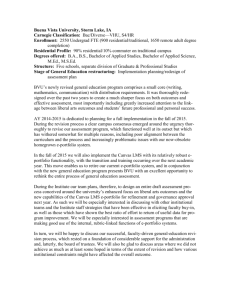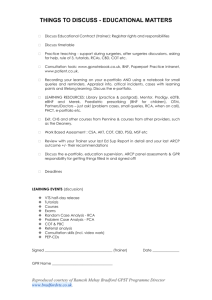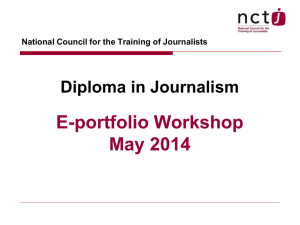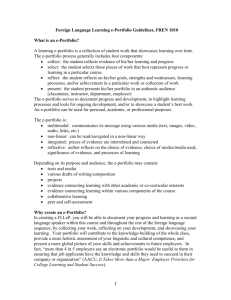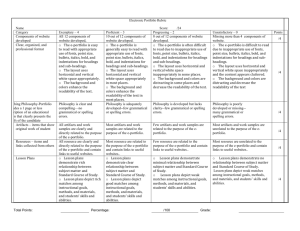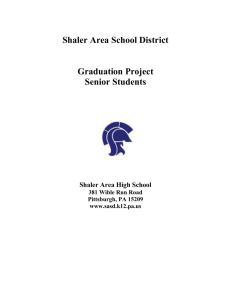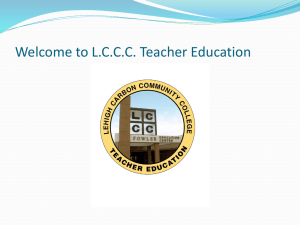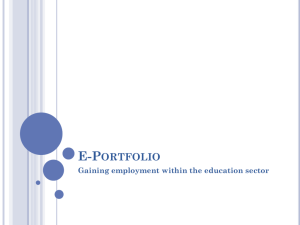Foreign Language Learning e-Portfolio (FLLeP
advertisement
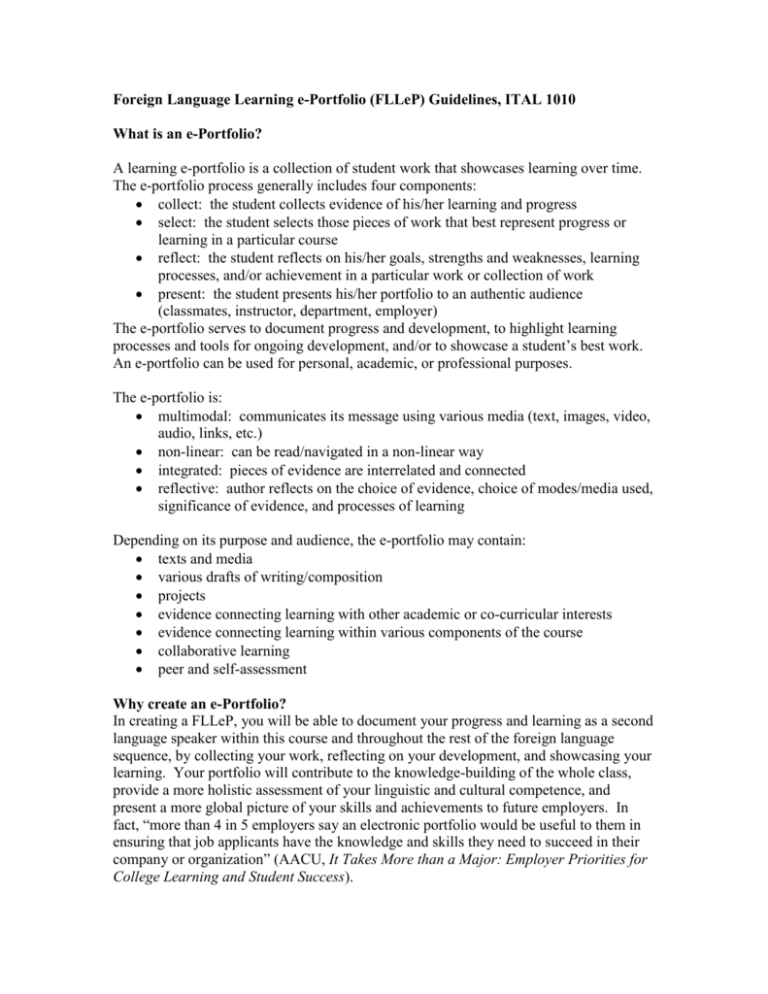
Foreign Language Learning e-Portfolio (FLLeP) Guidelines, ITAL 1010 What is an e-Portfolio? A learning e-portfolio is a collection of student work that showcases learning over time. The e-portfolio process generally includes four components: collect: the student collects evidence of his/her learning and progress select: the student selects those pieces of work that best represent progress or learning in a particular course reflect: the student reflects on his/her goals, strengths and weaknesses, learning processes, and/or achievement in a particular work or collection of work present: the student presents his/her portfolio to an authentic audience (classmates, instructor, department, employer) The e-portfolio serves to document progress and development, to highlight learning processes and tools for ongoing development, and/or to showcase a student’s best work. An e-portfolio can be used for personal, academic, or professional purposes. The e-portfolio is: multimodal: communicates its message using various media (text, images, video, audio, links, etc.) non-linear: can be read/navigated in a non-linear way integrated: pieces of evidence are interrelated and connected reflective: author reflects on the choice of evidence, choice of modes/media used, significance of evidence, and processes of learning Depending on its purpose and audience, the e-portfolio may contain: texts and media various drafts of writing/composition projects evidence connecting learning with other academic or co-curricular interests evidence connecting learning within various components of the course collaborative learning peer and self-assessment Why create an e-Portfolio? In creating a FLLeP, you will be able to document your progress and learning as a second language speaker within this course and throughout the rest of the foreign language sequence, by collecting your work, reflecting on your development, and showcasing your learning. Your portfolio will contribute to the knowledge-building of the whole class, provide a more holistic assessment of your linguistic and cultural competence, and present a more global picture of your skills and achievements to future employers. In fact, “more than 4 in 5 employers say an electronic portfolio would be useful to them in ensuring that job applicants have the knowledge and skills they need to succeed in their company or organization” (AACU, It Takes More than a Major: Employer Priorities for College Learning and Student Success). The FLLeP will allow students to: 1. make links between FL study and other academic and non-academic interests and pursuits 2. make links between (1) components of a course, (2) learning in class, at home, and online, (3) one language course and the next 3. develop an awareness of their progress, learning styles, goals in acquiring a second language, and tools for lifelong learning 4. discover, understand, and communicate what, how, when, and why they learn 5. develop digital literacy skills 7. archive their work and track their progress over time 8. engage in a critically reflective, collaborative process that augments learning as a community knowledge-building endeavor 9. publish work in a public forum and for an authentic audience 10. select multimedia artifacts that allow for a more multimodal and holistic assessment of second language development 11. construct and present an online FL learner identity Required Components The components of the e-portfolio have been carefully designed to promote the attainment of the learning goals described above. 1. About Me What do you want your audience to know about you? In the About Me page, tell your reader something about yourself, your academic and personal interests, and your experience with foreign languages. 2. Reflection 1: Getting Started In your initial reflection, you will describe your vision and goals for the course and specific steps and learning strategies that will lead you to attaining those goals. What have been your strengths and challenges in prior language learning experiences? How do you hope to approach those challenges in this course? What kinds of signs, accomplishments, etc., at the end of the course would tell you you’ve made progress? 3. Journal Reflections You will reflect on your language development, learning strategies, and goals in a short reflective informal journal entry a minimum of four times this semester. See syllabus for due dates. First, take a look at the goals you set in Reflection 1. Think about what you have achieved so far and what still needs to be accomplished for you to reach those goals. Try to identify 2-3 specific steps and learning strategies that will help you achieve your learning goals. 4. Cultural Competence Cultural learning means engaging in meaningful, deep reflection on the ways of life practiced by given populations around the world and to find connections with these people, the true meaning behind learning a language. What did you learn from these 2 assignments? What goals were you working toward when you did this work? Did you meet those goals? What learning 5. 6. 7. 8. 9. strategies did you use when you were doing these activities? Did they help you? What would you do differently next time? You will include: o Cultural Research Project o Video Project Writing This page will include both the first draft and final revision of your composition as well as a reflection on your process of writing and development of grammar and vocabulary in written contexts. What did you learn from this assignment? What goals were you working toward when you wrote the composition? Did you meet those goals? What learning strategies did you use when you were writing and revising? Did they help you? What would you do differently next time? o Composition -- first draft o Composition -- revision Speaking In what ways have your speaking and communicative skills improved during the semester? What learning strategies have you used when practicing speaking and pronunciation? Did they help you? What areas of speaking or pronunciation do you still need to work on thinking ahead to ITAL 1020? What can you do to improve in those areas? In this section, you will include the clips of: o Practice Oral Exam o Oral Exam Final Reflective Essay In your final reflective essay, you will reflect on what you learned during the semester, from engagement with your peers in class and online, and on your learning processes and ongoing linguistic and cultural development. Consider all aspects of your work toward becoming a better Italian speaker/listener/reader/writer and culturally aware global citizen. What are the strengths and weaknesses of your portfolio? What worked and what didn’t work? Discuss your choice of documents and selection of media to present your learning. What connections do you see between your learning and your other personal and academic interests? How will you apply what you learned in this course? What are your goals for ITAL 1020? Peer Interaction a. Commenting online. Throughout the semester, you will work in groups of 3-4 students to read each other’s portfolio entries and engage in online interaction using the comment feature. Showcase and Celebration of Final e-Portfolio a. At the end of the semester, you will present your final work to your peers and reflect on what you learned as a class from each other. Assessment Throughout the semester, you will engage in self-assessment and peer assessment of portfolios using the rubric online. E-Portfolio Tool You will create your FLL e-portfolio using WordPress embedded in Collab, using the online training tutorials here: http://tinyurl.com/tutorial-student. For any technical issues or questions, e-portfolio consultants will be available for office hours to help you. Do not contact your instructor with technical questions about WordPress. E-Portfolio consultant office hours will be posted on your course Collab site.
